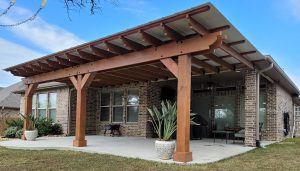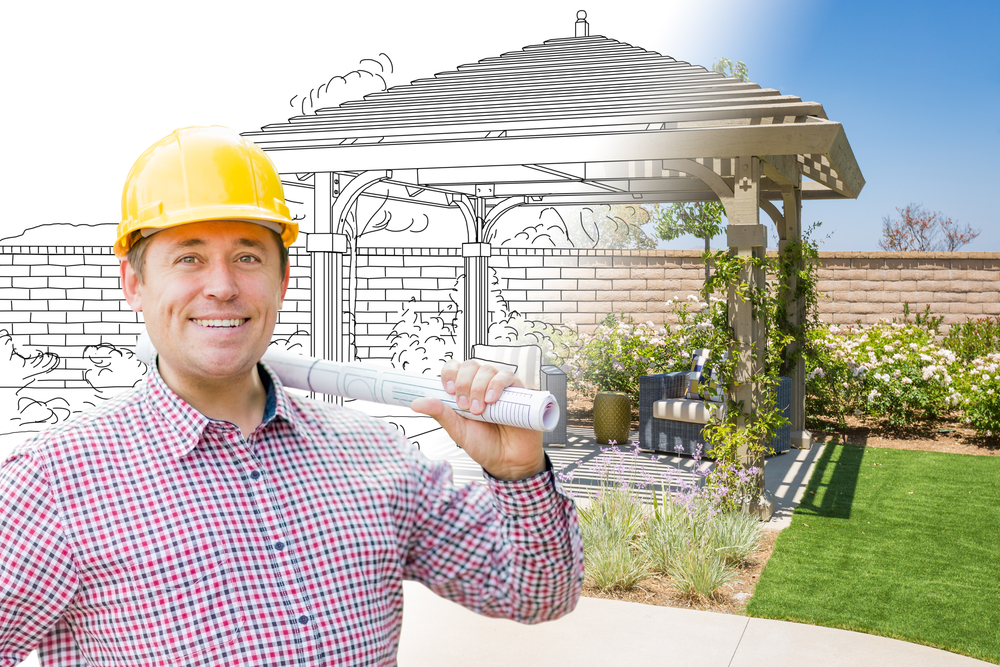Dreaming about a new outdoor patio? Before you start pouring concrete or picking out outdoor furniture, it’s important to take time to plan. A little preparation goes a long way in creating a space that’s both beautiful and functional.
When your outdoor patio design is thoughtfully planned, it becomes more than just an outdoor area; it transforms into an outdoor living room that feels like an extension of your home.
It’s where you can relax with coffee in the morning, host dinner with friends and family, or enjoy quiet evenings under string lights. A well-designed patio gives you the perfect spot to unwind, entertain, and make lasting memories right in your own backyard.
Assess Your Space
Before jumping into patio design ideas, start by getting to know your space. Grab a tape measure and take note of the size of your backyard or patio area. Knowing the dimensions helps you figure out what will realistically fit, whether that’s a dining set, lounge chairs, or a fire pit.
Pay attention to how the sun and shade move throughout the day. Does the area get full sun in the afternoon or stay shaded? This helps you decide where to place seating or if you’ll need a pergola or patio cover for extra comfort.
Don’t forget to look at your landscaping and nearby structures. Trees, gardens, fences, and your home’s exterior can influence your layout and style. Working with what’s already there not only saves time and money but also helps your new patio blend seamlessly into your living spaces.

Define Your Patio’s Purpose
Before choosing materials or furniture, think about how you’ll actually use your patio. Is it for weekend barbecues and outdoor dining? A place to relax after work? Or a mix of both? Knowing your main purpose helps guide every design decision that follows.
If your goal is entertainment, create open zones with room for dining tables, seating, and maybe even an outdoor kitchen. For relaxation, focus on comfort, soft lighting, warm textures, and ways to create a cozy atmosphere. If dining is your priority, ensure you have enough space for your table and guests to move comfortably.
Choose the Right Materials
| Material | Pros | Cons / Considerations | Best For |
|---|---|---|---|
| Concrete | Durable, budget-friendly, customizable with stains or stamps | Can crack over time, may need sealing | Modern patio styles |
| Pavers | Flexible patterns and colors, easy to repair | Can shift if the base isn’t properly prepared | Patios with intricate designs |
| Natural Stone | Timeless and elegant, unique look | Higher cost, heavier installation | Luxury or high-end patios |
| Wood | Warm, charming, natural feel | Requires regular sealing and maintenance | Cozy outdoor patios |
| Composite | Low-maintenance, long-lasting, mimics wood | Higher upfront cost than wood | Durable, low-maintenance patios |
Plan the Layout
Once materials are chosen, think about how your patio will be arranged. A good patio layout makes your outdoor rooms feel inviting and easy to use. Consider traffic flow and ensure there’s space between seating, walkways, and doors.
Plan your zones, maybe a dining area for meals, a lounge for relaxing, and a fire pit corner for evening gatherings. Add focal points like a fountain, garden feature, or stunning view, and arrange your furniture to highlight them.
Your patio should feel connected to your yard, with landscaping guiding the layout and adding charm. This creates a seamless flow and turns your backyard into a true backyard oasis.
Add Functional Features
- Shade: Use a pergola, umbrella, or awning to stay cool in the sun.
- Lighting: Add lights so your patio is safe and looks nice at night.
- Outdoor Kitchen: Cook and eat outside easily.
- Fire Pit: A warm, cozy spot for evenings.
- Water Feature: Fountains or small ponds for beauty and relaxing sounds.

Select Furniture and Decor
When choosing furniture and décor, match the style to your overall outdoor patio design. Select durable, weather-resistant pieces that will hold up over time. Accessories like plants, rugs, and pillows in bold colors can add personality and warmth.
Browse outdoor patio design pictures online or in catalogs for inspiration. These can help you visualize how your space will come together and inspire creative touches that make your patio feel uniquely yours.
Budgeting and Timeline
Estimate how much you’ll spend on materials, labor, and features like lighting or furniture. Prioritize the most important elements first, and consider completing smaller updates over time to stay within budget. A clear timeline keeps your project organized from start to finish.
Frequently Asked Questions
What size should my patio be?
Start by measuring your space and thinking about how you plan to use it. Make sure there’s enough room for furniture, walking paths, and any features like a fire pit or dining area. Matching the size to your needs helps the patio feel comfortable, not crowded.
Which materials are best for an outdoor patio?
Popular options include concrete, pavers, natural stone, wood, and composite decking. Concrete is durable and budget-friendly, pavers are flexible and easy to repair, natural stone is elegant but pricier, wood is warm but needs regular care, and composite is low-maintenance and long-lasting.
How do I make my patio suitable for entertaining?
Plan seating areas, dining spaces, and activity zones that allow people to move around freely. Adding a mix of tables, chairs, and lounge spots helps your patio work for both meals and social gatherings.
Do I need shade or cover for my patio?
Shade can make your patio much more comfortable. Consider pergolas, umbrellas, or awnings to protect against sun and light rain.
How much does it cost to design and build a patio?
Costs depend on materials, size, labor, and any extra features like lighting, fire pits, or outdoor kitchens. Planning carefully and setting priorities can help you stay on budget.
How do I maintain my patio over time?
Regular cleaning, sealing, and seasonal care will keep your patio looking good and lasting longer. The exact steps depend on the materials you choose.
Can I design a patio myself, or should I hire a professional?
You can plan a patio yourself if you’re comfortable with measuring, layout, and materials. A professional can help with complex designs, permits, or installations that require specialized skills.
What outdoor features improve the look and functionality of a patio?
Lighting, fire pits, water features, and decorative accents can make your patio more inviting and practical for different activities.
How do I integrate my patio with my existing landscaping?
Consider the flow of your yard, plant placement, and natural features. Arranging your patio to connect with gardens, pathways, or trees creates a cohesive look.
How can I make my patio comfortable year-round?
Think about adding heating, shading, and weather-resistant furniture. These choices allow you to enjoy your patio in different seasons without discomfort.
Plan and Design an Outdoor Patio
Planning and designing an outdoor patio takes a little time, but the results are worth it. From assessing your space and choosing materials to adding functional features and furniture, each step helps create a patio that is both beautiful and practical. With careful planning, your patio can become the perfect spot for relaxing, entertaining, and enjoying the outdoors.
As an outdoor design and construction company serving College Station, we specialize in creating custom patios that fit your lifestyle and space. Learn more about our approach and services on our About page.
Ready to bring your dream patio to life? Request a consult today and start planning your perfect outdoor space.



